The physio-chemical resilience of zircons has been key in their increasing application to deciphering geological processes through Earth history. However, zircons are not immune to mechanical abrasion and chemical alteration. This study quantifies the loss of zircon rims from the Brahmaputra source-to-sink (S2S) system, which drains the Himalayan-Tibetan orogen and transports sediment to the deep Bay of Bengal over a total vertical relief of some 7000 m. During sediment transport from this S2S system, median zircon rim thickness decreases by ~50%, suggesting that information contained in the rim would be lost after reworking of grains through two orogenic and associated sedimentary cycles. To validate this discovery at a global scale, we apply Monte Carlo weighted bootstrap resampling of a global detrital zircon core and rim age data set. After the impacts from changing tectonic regime (increasing metamorphic rim since the late Neoproterozoic and rim formation during continental collision events) were decoded, proportions of rim versus core increase over time and clearly show that old rims have been erased after several rounds of sediment recycling in response to multiple orogenic cycles. Our work suggests that crustal information archived in zircons can be lost during surficial sediment transport in addition to deep crustal-recycling processes such as lithospheric delamination, subduction erosion, and sediment subduction.
Article link: https://doi.org/10.1130/G53821.1




 Address
Address
 E-Mail
E-Mail
 Telephone
Telephone